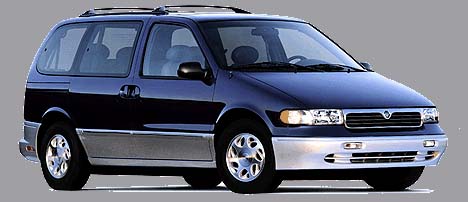
SEE ALSOL Mercury Buyer's Guide
There's no denying that the Mercury Villager is in the top ranks of minivans. I personally feel the Chrysler minis are the best, especially with the new door on the driver's side, but the Villager and its stablemate, the Ford Windstar, give the Chrysler trio a good run for their money. In many cases, it is the presence or absence of certain features (other than extra sliding doors) that makes the difference.
The top-of-the-line villager is the Nautica, which has some nice trim options to go along with a sexy paint job. The Nautica option also is responsible for, perhaps, the one bad feature about the Mercury Villager, and that's the price. While it's a nice minivan, it certainly isn't worth $30,000.
Villager is powered by a 3.0-liter V-6, which drives the front wheels through a four-speed automatic gearbox. This is a fairly standard configuration for minis today. The 3.0-liter engine is rated at 151 horsepower, which is pretty good for this van. Acceleration was goad and top speed was good, and on-the-road acceleration was also good. It gave the Villager a sporty feel. The benefit of minivans, at least in the beginning, was that they were almost car-like. they're far more car-like than they are van-like. The power available from this engine gives the Villager almost car-like performance and makes it fun to drive.
I enjoyed the Villager on my daily commuter, which includes a twisting mountain road. I also used the Villager on some Interstates and smoother, straighter roads and it performed well there as well. Oddly enough, we also did some truckin' with the Villager. I had to make a delivery and was able to configure the seats so that it did its job well.
When my daughter moved into her new apartment, we were able to remove the seats and had over 126 cubic feet of cargo room to pack things.
Villager has a-simple instrument panel with, in this case, a digital speedometer, bar graph fuel and water gauges, and a fuel management computer, which told us we averaged about 20.4 mpg during our test. In addition, we had all the necessary luxuries that made it so expensive. I also liked the dual air bags, which help make the Villager safer (always wear your seat belts). The power sunroof on the tester is something you don't always see in a minivan.
Handling of the villager was surprising. It has a fairly conventional MacPherson strut front rear suspension and a beam rear axle. Yet it handled itself well on the winding roads. There was not excessive lean. On one stretch I was following a full-sized van and this vehicle was leaning quite a bit in the turns and must have been a handful for the driver. I remember our full-size van was not a great vehicle to drive around bends in the road. But the Villager's lower center of gravity and a suspension that seemed to be tuned to the characteristics of the vehicle made for a good ride.
I still think that the added practicality of the driver's side door gives the Chrysler minivans a slight -edge, just like the added practicality of Ford's extra door in extended cab pickups gives the F-150 the edge. But it's the exceptional features of the Villager that forced Chrysler to turn the wick up a bit. It will be interesting to see how Mercury trims the wick in its next generation of mini. I would like to see a more reasonable price, though.